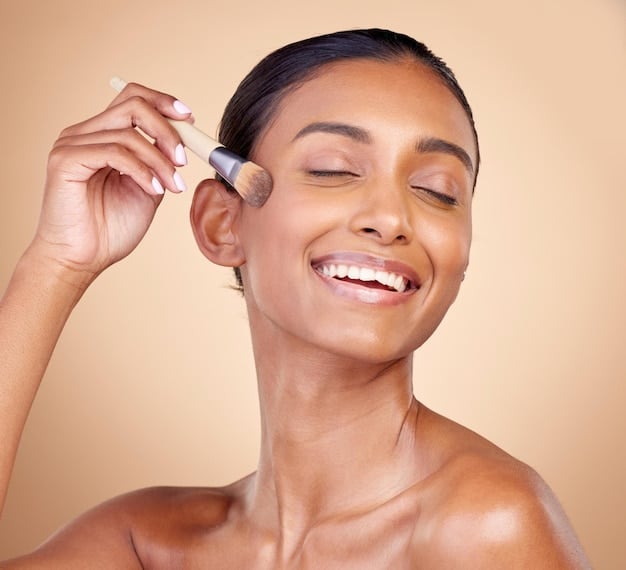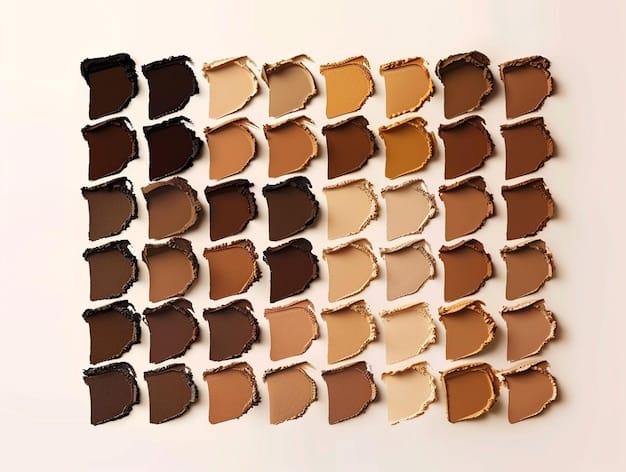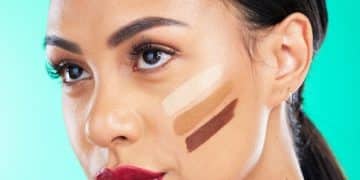How to Choose the Right Foundation: Your 2025 Skin Type Guide

Advertisements
Choosing the right foundation in 2025 involves understanding your skin type, considering different formulations, and matching the shade to your skin tone for a flawless, natural-looking finish.
Advertisements
Finding the perfect foundation can feel like searching for a needle in a haystack. But fear not! This guide on how to choose the right foundation: a makeup tutorial for your skin type in 2025 will break down everything you need to know to achieve a flawless complexion.
Understanding Your Skin Type
Advertisements
Before diving into the world of foundations, it’s crucial to identify your skin type. Knowing whether you have oily, dry, combination, or sensitive skin will significantly impact the type of foundation that works best for you. This will help you address specific concerns and achieve the desired finish.
Oily Skin
Oily skin is characterized by excess sebum production, leading to a shiny appearance and often enlarged pores. Those with oily skin may also be prone to breakouts.

- Look for oil-free and non-comedogenic foundations.
- Matte finishes are ideal for controlling shine throughout the day.
- Powder foundations or liquid foundations with oil-absorbing properties are good choices.
Dry Skin
Dry skin lacks moisture, often feeling tight and flaky. It can sometimes appear dull and be more prone to fine lines. Hydration is key for dry skin.
- Opt for hydrating foundations that contain moisturizing ingredients like hyaluronic acid or glycerin.
- Cream or liquid foundations with a dewy finish can help create a radiant complexion.
- Avoid matte foundations, as they can accentuate dryness.
Combination Skin
Combination skin features both oily and dry areas, typically with an oily T-zone (forehead, nose, and chin) and dry cheeks. Balancing hydration and oil control is important.
- Choose foundations that offer a balance between hydration and oil control.
- Look for formulas labeled as “for all skin types” or “balancing.”
- Consider using different foundations on different areas of the face to address specific concerns.
Sensitive Skin
Sensitive skin is easily irritated and prone to redness or allergic reactions. Gentle and hypoallergenic formulas are a must.
- Select foundations that are fragrance-free, hypoallergenic, and non-comedogenic.
- Mineral foundations with minimal ingredients can be a safe bet.
- Always patch-test new products before applying them to the entire face.
Understanding your skin type is the first step toward finding the perfect foundation. By addressing your skin’s specific needs, you can choose a foundation that not only provides coverage but also improves the overall health and appearance of your skin.
Exploring Foundation Formulations
Foundations come in various formulations, each with its own set of benefits and drawbacks. From liquids to powders, knowing the characteristics of each type can help you make an informed decision based on your skin type and desired finish.
Liquid Foundations
Liquid foundations are versatile and come in a wide range of finishes, from matte to dewy. They are suitable for most skin types and offer buildable coverage.
- Pros: Buildable coverage, variety of finishes, suitable for most skin types.
- Cons: Can be messy to apply, may require additional tools like brushes or sponges.
Powder Foundations
Powder foundations offer lightweight coverage and are ideal for oily or combination skin. They help control shine and provide a matte finish.
- Pros: Easy to apply, good for oily skin, controls shine.
- Cons: Can look cakey if overapplied, may not provide enough coverage for some.
Cream Foundations
Cream foundations are rich and hydrating, making them suitable for dry or mature skin. They offer medium to full coverage and a dewy finish.
- Pros: Hydrating, good for dry skin, provides medium to full coverage.
- Cons: Can feel heavy on oily skin, may require careful blending.
Stick Foundations
Stick foundations offer convenient and portable coverage. They are easy to apply and blend, making them a good option for on-the-go touch-ups.
- Pros: Portable, easy to apply, good for touch-ups.
- Cons: Can be less blendable than other formulations, limited shade range.
BB and CC Creams
BB (Beauty Balm) and CC (Color Correcting) creams are lightweight alternatives to traditional foundations. They offer sheer coverage and often contain skincare benefits like SPF and antioxidants.
- Pros: Lightweight, contains skincare benefits, good for everyday wear.
- Cons: Sheer coverage, may not be suitable for those who need more coverage.
Choosing the right foundation formulation depends on your skin type, desired coverage, and personal preference. Experiment with different types to find the one that works best for you and provides the perfect base for your makeup look.
Matching Your Shade Perfectly
One of the most crucial aspects of finding the right foundation is matching the shade to your skin tone. An incorrect shade can make your makeup look unnatural and unflattering. Here’s how to ensure you find the perfect match.
Understanding Undertones
Undertones are the subtle hues beneath the surface of your skin, which can be warm, cool, or neutral. Knowing your undertone will help you choose a foundation with the right balance of pigments.
To determine your undertone:
- Vein Test: Look at the veins on your wrist. Blue or purple veins indicate a cool undertone, while green veins suggest a warm undertone. If you can’t tell, you likely have a neutral undertone.
- Jewelry Test: Consider what jewelry looks best on you. Gold tends to complement warm undertones, while silver looks better on cool undertones.
- Sun Test: Observe how your skin reacts to the sun. If you tan easily, you likely have a warm undertone. If you burn easily, you probably have a cool undertone.

Testing Shades
Always test foundation shades on your jawline in natural light. This will give you the most accurate representation of how the foundation looks on your skin. Avoid testing on your hand, as the skin tone there is often different from your face.
Adjusting for Seasons
Your skin tone may change throughout the year due to sun exposure. You may need to adjust your foundation shade accordingly, using a lighter shade in the winter and a darker shade in the summer.
Finding your perfect foundation shade may require some trial and error, but with these tips, you’ll be well on your way to achieving a flawless and natural-looking complexion.
Application Techniques for a Flawless Finish
Even with the right foundation, the application technique can make or break your look. Proper application ensures even coverage, a natural finish, and long-lasting wear. Here are some tips for achieving a flawless foundation application.
Preparing Your Skin
Start with a clean and moisturized face. Exfoliating regularly can help create a smooth canvas for foundation application. Use a primer to create a smooth, even surface and help your foundation last longer.
Choosing the Right Tools
Different application tools can provide different finishes. Here are some popular options:
- Makeup Brushes: Offer precise application and buildable coverage.
- Makeup Sponges: Provide a seamless, airbrushed finish.
- Fingers: Can be used for light coverage and a natural finish.
Applying the Foundation
Apply a small amount of foundation to the center of your face and blend outwards. Avoid dragging the product, as this can create streaks. Instead, use a stippling or dabbing motion to press the foundation into the skin.
Setting the look
setting is key to ensuring your foundation lasts all day and looks flawless. After you’ve applied your foundation, use a setting powder and setting spray.
- Setting Powder: Dust a thin layer of setting powder on top of the foundation. This will help to ensure that the foundation will last.
- Setting spray: Spray the setting spray all over your face. This will meld the foundation and powder for a smooth look.
Proper application techniques are essential for achieving a flawless foundation finish. By preparing your skin, choosing the right tools, and using the correct application method, you can ensure your makeup looks professional and lasts all day.
Longevity and Wear: Tips for All-Day Perfection
You’ve found the right foundation, matched the shade, and mastered the application. But how do you ensure your flawless base lasts all day? Here are some tips to enhance the longevity and wear of your foundation.
Setting the Foundation
Setting the foundation with powder is crucial for preventing it from sliding off your face. Use a lightweight translucent powder to set the foundation without adding extra coverage. Focus on areas that tend to get oily, such as the T-zone.
Using a Setting Spray
A setting spray can help lock your makeup in place and prevent it from fading or creasing. Choose a setting spray that is suitable for your skin type, whether it’s mattifying for oily skin or hydrating for dry skin.
Blotting Throughout the Day
If you have oily skin, carry blotting papers with you to absorb excess oil throughout the day. Gently press the blotting paper onto your skin to remove shine without disturbing your makeup.
Avoiding Touching Your Face
Touching your face can transfer oils and bacteria, causing your foundation to break down and fade. Be mindful of this habit and try to avoid touching your face as much as possible.
Choosing Long-Wearing Formulas
When selecting a foundation, look for formulas that are designed to be long-wearing and transfer-resistant. These foundations are formulated to stay put for hours, even in humid conditions.
Ensuring the longevity and wear of your foundation involves proper setting, using a setting spray, blotting excess oil, avoiding touching your face, and choosing long-wearing formulas. By following these tips, you can maintain a flawless complexion throughout the day and look your best from morning till night.
Foundation Trends in 2025
As we look ahead to 2025, several foundation trends are emerging that promise to revolutionize the way we achieve flawless skin. From innovative formulations to application techniques, staying updated with these trends can help you stay ahead of the curve.
Skinimalism
Skinimalism is all about embracing a more natural and minimalist approach to makeup. This trend encourages using lightweight foundations or tinted moisturizers that provide sheer coverage while allowing your natural skin to shine through.
Customizable Foundations
Customizable foundations are gaining popularity, allowing you to create a personalized shade and formulation that perfectly matches your skin tone and type. These foundations often come with mixers or adjusters that allow you to tweak the color and consistency.
Sustainable and Eco-Friendly Options
With growing awareness of environmental issues, sustainable and eco-friendly foundations are on the rise. These foundations are formulated with natural and ethically sourced ingredients, and they often come in recyclable or biodegradable packaging.
Hybrid Formulas
Hybrid formulas combine the benefits of skincare and makeup, offering coverage while also addressing specific skin concerns. These foundations often contain ingredients like hyaluronic acid, antioxidants, and SPF to nourish and protect the skin.
High-Tech Innovations
High-tech innovations are influencing the foundation industry, with advancements like virtual try-on tools and AI-powered shade matching systems. These technologies make it easier than ever to find the perfect foundation shade and formulation from the comfort of your home.
Staying informed about foundation trends in 2025 can help you make informed decisions about your makeup routine. Whether you’re embracing a minimalist approach, exploring customizable options, or opting for sustainable formulas, these trends offer exciting new ways to enhance your natural beauty and achieve a flawless complexion.
| Key Point | Brief Description |
|---|---|
| 🔍 Skin Type | Identify if you have oily, dry, combination, or sensitive skin. |
| 🎨 Shade Matching | Test shades on your jawline in natural light to find the perfect match. |
| ✨ Application | Use the right tools and techniques to achieve a flawless finish. |
| 📅 2025 Trends | Stay updated with trends like skinimalism and customizable foundations. |
FAQ
▼
Observe your skin throughout the day. If it feels tight and flaky, you likely have dry skin. If it’s shiny, you have oily skin. Combination skin has both oily and dry areas.
▼
Test shades on your jawline in natural light. The shade that disappears into your skin is the closest match. Consider your undertones as well when testing.
▼
Most foundations have a shelf life of 12-24 months after opening. Pay attention to changes in texture, smell, or color, which can indicate it’s time to replace it.
▼
Yes, mixing foundations can help you achieve a custom shade or finish. Experiment with different combinations to find what works best for your skin and desired look.
▼
Avoid applying too much foundation, using the wrong shade, skipping primer, and neglecting to blend properly. Focus on building coverage gradually for a natural look.
Conclusion
Choosing the right foundation for your skin type in 2025 involves understanding your skin’s needs, exploring different formulations, matching your shade perfectly, mastering application techniques, and staying updated with the latest trends. By following this comprehensive guide, you can achieve a flawless and natural-looking complexion that enhances your beauty and boosts your confidence.





